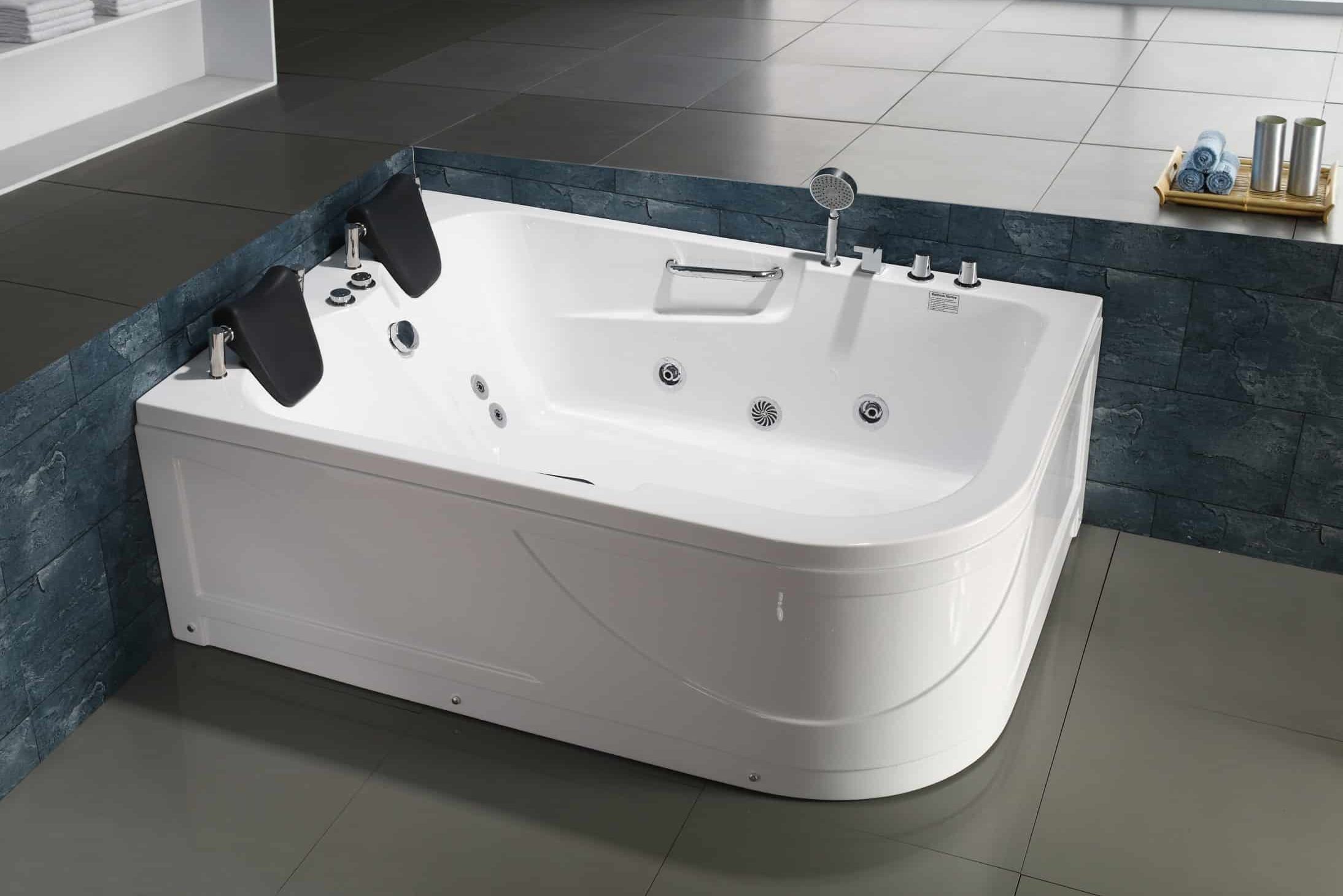Key Takeaways -
- Whirlpools, often known as jetted tubs and jacuzzis, are popular recreational activities used to relax and unwind.
- However, there is a common misconception that whirlpools are inherently dirty or unsafe.
- While it’s true that improper maintenance and use of a whirlpool can lead to health issues like infections, in general, these risks can be easily mitigated with proper care.
- To ensure that your whirlpool bath is clean and sanitary, regularly clean your bath to keep it free of grime and soap scum.
You may have heard of whirlpool shower baths and their many benefits, but you may also be asking: are they safe? Any risks associated with whirlpool baths come down to one thing – germs.
While a few myths have been built up over the years, hydrotherapy tubs and Jacuzzis can actually be quite sanitary if they’re properly taken care of and cleaned regularly.
In this article, we’ll take a close look at the germy facts surrounding whirlpools so that you can make an informed decision about whether or not these types of baths are right for you.

What is a Whirlpool Bath?
A whirlpool bath is a type of bathing experience designed to provide RELIEF from sore muscles and aches. It uses an air-jet system to create a powerful stream of bubbles that relaxes the body and mind.
In addition to providing a spa-like atmosphere, research has shown that whirlpool baths can help IMPROVE circulation, reduce joint pain and stiffness, as well as alleviate stress (not just in the bathtub, either!).
With all these benefits, it’s no wonder why many people are opting for whirlpools in their homes.
Common Myths Surrounding Whirlpool Baths
Myth: One of the most common myths surrounding whirlpool baths is that they are UNHYGENIC and can spread germs.
Fact: This is not true. Whirlpool baths are capable of MAINTAINING high levels of hygiene thanks to filtration systems that disinfect and clean the circulating water.
Myth: Another myth is that there is STAGNANT water in the pipes, which can cause health issues if inhaled.

Fact: Modern whirlpool bath systems use pumps to keep the water CONSTANTLY circulating, so there is no stagnant water buildup.
Myth: Many people believe it is DIFFICULT to keep whirlpool baths clean
Fact: It can be quite EASY to keep a whirl pool bath clean. Simply treating the bath with an appropriate cleaning solution regularly will ensure low levels of bacteria and germs, making them both hygienic and safe for use.
Pro Tip: hot soapy water is great for cleaning the sides and jets of a whirlpool bath.

Health Concerns for Hydrotherapy Tubs and Jacuzzis
Though hydrotherapy tubs and Jacuzzis offer a VARIETY of benefits, there are some health concerns that should be taken into account when using them.
Infections and Illnesses
Another potential danger associated with whirlpools is INFECTION. A study by a Texas A&M University microbiologist showed that whirlpool bathtubs could be a breeding ground for dozens of types of bacteria, many of which can cause infections and illnesses [1].
Additionally, some people have raised CONCERNS about the possibility of Legionnaires’ disease being spread through whirlpool baths due to their warm temperatures and moist environment [4].

Hot Tub Rash
In addition to infections and illnesses, hot tubs can cause a skin RASH known as “hot tub folliculitis.” This condition is caused by bacteria that thrive in warm, moist environments such as whirlpool baths [2].
If left UNTREATED, this rash can lead to severe itching and burning sensations in the affected areas. To reduce the risk of developing this rash, it is important to keep your bathtub clean and free from soap scum.
Types Of Diseases Linked To Whirlpool Bathtubs
Types of diseases linked to whirlpool bathtubs include:
- Influenza
- Skin infections such as folliculitis
- Earaches
- Diarrhea
- Rashes
- Respiratory illnesses
- Eye infections
- Staphylococcal scalded skin syndrome
- Pseudomonas infection
- Legionnaires’ disease
- Urinary tract infections
Although these diseases are rare when proper safety precautions are taken, it is important to be aware of them so that any potential health issues can be addressed quickly and effectively.

Ways To Prevent Infections From Whirlpools
To reduce the risks of infection from whirlpools, consider taking the following precautions:
- Clean filters and other components regularly (including whirlpool jets).
- To keep your whirlpool system clean and safe.
- Avoid the temptation to overcrowd your bathtub.
- No one with any open wounds or sores should be permitted to use this tub.
- For your safety, kindly refrain from sharing towels, bathrobes and other items with others.
- For optimal health, restrict your stay in hot water to no more than 20 minutes.
What Are The Biggest Dangers With Whirlpool Tubs?
When it comes to whirlpool tubs, there is a lot of debate about the SAFTEY of these popular fixtures. While they can be a great way to relax and unwind after a long day, there are some potential dangers associated with them that should not be overlooked.

Risk of Burns
The biggest danger with whirlpool baths is MISUSE. It is important to remember that hot water can cause serious burns if you stay in the tub for too long. According to the specialist, jetted tubs should not be used for more than 20 minutes at a time [3].
In addition, it is important to ensure that the TEMPERATURE of the water does not exceed 104 degrees Fahrenheit (40 degrees Celsius). This will help reduce the risk of scalding or burning your skin.
Electrical Shock
Another potential danger with whirlpool baths is the potential for electric shock. It is important to ensure that all electrical components are PROPERLY installed and maintained in order to reduce the risk of electrocution.

Slip/Trip Hazard
Whirlpools can be a potential slip or trip hazard. Make sure to keep the area around the tub FREE from clutter and debris in order to reduce the risk of slipping or tripping.
Additionally, always keep a TOWEL nearby so that you can dry off after getting out of the tub. This will help reduce the risk of slipping on a wet surface.
Dangerous For Children
Finally, it is important to note that children are particularly VULNERABLE when using whirlpool baths due to their smaller size and inability to regulate their body temperature as well as adults.
It is, therefore, important for parents and caregivers to closely MONITOR children while they are using these fixtures so that they do not become overheated or suffer any other type of injury or illness related to their use.

Frequently Asked Questions
Do Whirlpool Tubs Get Mouldy?
To avoid the growth of mould, it is essential to keep your whirlpool properly maintained. Regularly clean and drain out any stagnant water from the tub and ensure that each part is free from dirt or other particles.
Are Whirlpool Tubs Safe?
Although whirlpools are safe if used correctly and maintained regularly, it is essential to remember that they come with risks, such as the potential for electrical shock, burns and mould growth.
Thus, it is essential to exercise proper safety measures and a close eye on kids in the bathtub to prevent potential hazards.

Conclusion
Taking the right precautions and ensuring your whirlpool is clean of dirt or soap scum will make it a safe, hygienic oasis. With proper maintenance, you can bask in its therapeutic waters without worry.
Nevertheless, it's critical to keep in mind that there are potential risks associated with using these fixtures, including burns, electric shock or illnesses stemming from bacteria in the water. That being said, you must take all essential precautions to guarantee your whirlpool is secure.
Sources -
- A Risky Soaking: Study Shows Whirlpool Water Can Be Dangerous «SpaKleen cleaner for whirlpool, spa, and jetted baths. Spa-kleen.com. Published 2016. Accessed February 15, 2023. https://spa-kleen.com/a-risky-soaking-study-shows-whirlpool-water-can-be-dangerous/
- Hot Tub Rash. Published 2023. Accessed February 15, 2023. https://www.cdc.gov/healthywater/swimming/swimmers/rwi/rashes.html
- Hot Tub Safety: What You Need to Know | Jacuzzi.com | Jacuzzi® Canada. Jacuzzi.com. Published 2023. Accessed February 15, 2023. https://www.jacuzzi.com/en-ca/Hot-Tub-Safety-What-You-Need-to-Know.html#
- Lucy. LEGIONELLA AND HOT TUBS - What you need to know! - OC Spas. OC Spas. Published February 24, 2017. Accessed February 15, 2023. https://www.ocspas.co.uk/legionella-hot-tubs-need-know/#
Content editor, marketer and product tester. A regular contributor for the ‘Home And Garden’ and Modern Homes Magazines, now part of a close-knit team, I oversee all the content on Posh. All roads have led to this job which I love. I get to focus on my love of interior design and health and work with a fabulous team. The role brings me a good level of freedom to my family and me and keeps me productive












